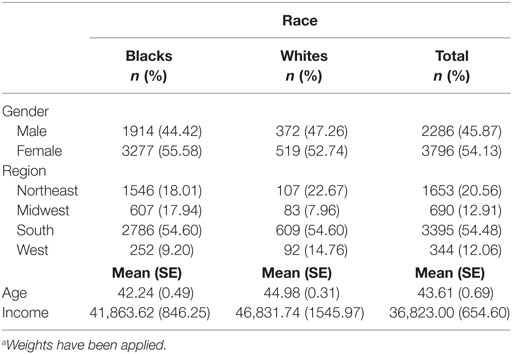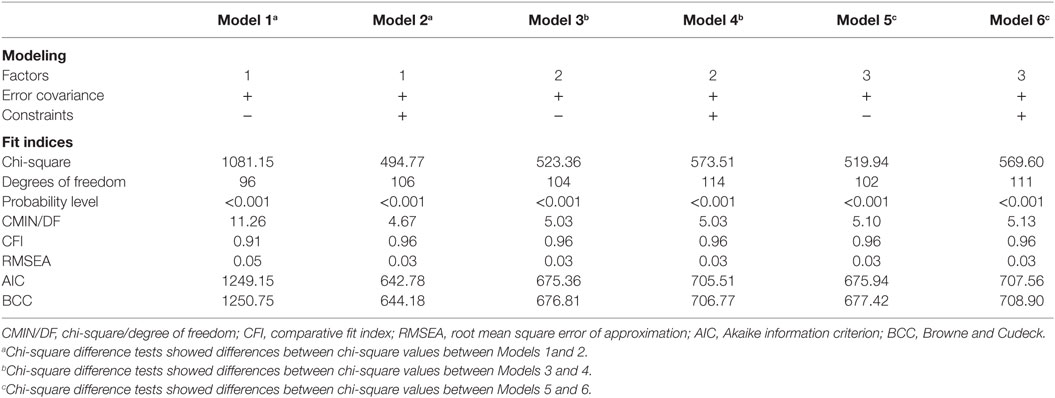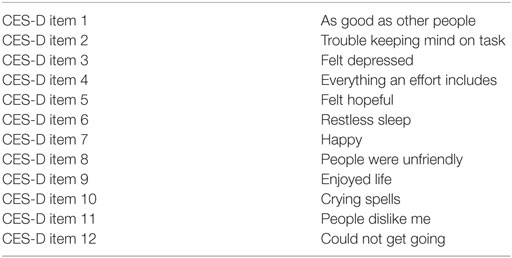- 1Department of Psychiatry, University of Michigan, Ann Arbor, MI, USA
- 2Center for Research on Ethnicity, Culture and Health, School of Public Health, University of Michigan, Ann Arbor, MI, USA
- 3Psychiatric Research Center, Roozbeh Hospital, Tehran University of Medical Sciences, Tehran, Iran
- 4Mental Health Research Center, Tehran Psychiatric Institute, School of Behavioral Sciences and Mental Health, Iran University of Medical Sciences, Tehran, Iran
Background: The Center for Epidemiologic Studies Depression (CES-D) scale is one of the most widely used tools to measure depressive symptoms in epidemiological studies. Given the importance of cross-racial measurement equivalence of the CES-D scale for research, we performed confirmatory factor analysis (CFA) of the 12-item CES-D in a nationally representative sample of Black and White adults in the United States.
Methods: We used data from the National Survey of American Life (NSAL), 2001–2003. A total number of 3570 Blacks (African-Americans) and 891 non-Hispanic Whites were included in the present study. CFA was carried out on the 12-item CES-D scale using multi-group structural equation modeling.
Results: For both Blacks and Whites, the best fitting model was found to be the 3-factor model, indicating invariance of factor structure between Blacks and Whites. A statistically different fit of the models with and without constraints indicated lack of invariance of factor loadings between Blacks and Whites. Some of the positive (i.e., “as good” and “hopeful”) and interpersonal (i.e., “people were unfriendly”) items showed poor loadings, even in the 3-factor solution that allowed separate domains for positive affect, negative affect, and interpersonal problems. Despite the good fit of our final model, more items (i.e., “as good,” “hopeful,” “keeping mind,” and “everything effort”) had poorer loadings in Blacks than Whites (i.e., “as good”).
Conclusion: There is invariance in factor structure but lack of invariance in factor/item loadings between Blacks and Whites. These findings have implications for cross-racial studies of depressive symptoms using CES-D scale among Blacks and Whites. Further research is warranted to scrutinize the role of socioeconomics and culture in explaining the lack of invariance of the CES-D scale between Blacks and Whites.
Introduction
Depression accounts for the largest portion of global burden of mental disorders (1). Considering that cross-ethnic studies have estimated the prevalence of depression ranging from 1.5 to 32% across ethnicities (2–5), accurate measurement of depression as well as depressive symptoms across racial and ethnic groups has attracted special attention (6–13). The Center for Epidemiologic Studies Depression scale (CES-D) is one of the most commonly used tools for measuring depressive symptoms in epidemiological (13) as well as clinical (14) studies. Since the introduction of the original 20-item CES-D scale, which evaluates major domains of depressive symptoms (i.e., 7 items of negative affect, 4 items of positive affect, 7 items of somatic symptoms, and 2 items of interpersonal problems), different abbreviated versions with variable number of items have been applied in epidemiological studies, (13–25) among them the widely used 20-item and 10-item CES-D scales (13, 19). The abbreviated versions were mainly developed to lower respondent burden and accelerate administration and scoring of the scale (18). They mostly reduced on the number of items for negative affect and somatic symptoms while sparing items for interpersonal problems. In this way, a 12-item version of the CES-D scale has also been developed and used in some major epidemiological studies including the National Survey of American Life (NSAL) (22, 25).
Measurement equivalence of the CES-D scale between Blacks and Whites has been the focus of several studies since its first application (13, 15–23). For example, some studies have reported lower overall reliability of the scale for measurement of depressive symptoms (17) but higher reliability of negative affect and interpersonal problem domains (15) of the 20-item CES-D scale in Blacks compared to Whites. There are also studies showing invariance of factor structure for both 10-item (16) and 20-item (17) CES-D scale across racial and ethnic groups. Studies that have found a lack of invariance for some of the CES-D scale items have concluded that response to some of the CES-D scale items may be group specific (16).
In a recent longitudinal study, using Americans’ Changing Lives data, despite the high reliability of an 11-item version of CES-D scale in both Blacks and Whites, CES-D scale total score was predictive of depression 15 years later in Whites but not Blacks based on diagnosis by Composite International Diagnostic Interview (CIDI). In this study, the CES-D scale item “people disliked me” loaded better into the positive affect factor in Blacks but better into the interpersonal problems factor in Whites (24). In another cross-sectional study on NSAL data using the 12-item CES-D scale, CES-D scale negative affect and interpersonal problem domains were more strongly associated with CIDI-based major depressive disorder (MDD) in Blacks compared to Whites (25).
In a study on older adults using the 20-item CES-D scale, Blacks endorsed disproportionately higher interpersonal problem items than Whites. That study also found higher loadings for interpersonal problem items in the single factor solution for the CES-D scale (26). In another study that compared low socioeconomic Blacks and a sample of Blacks and Whites based on the 20-item CES-D scale, different item loadings were found between Blacks and Whites. While items better loaded into negative affect and interpersonal problem domains for Blacks, the items better loaded into positive affect domain for Whites (27). Other researchers found similar patterns when comparing Black and White samples stratified on gender using the 20-item CES-D scale (28). Comparing sociodemographically matched Black and White pregnant women, Canady et al. found that the positive item “happy” was the only item among the 20 items with different loadings between Blacks and Whites (29). This finding was similar to what Moazen-Zadeh and Assari found recently investigating the 11-item version of the CES-D scale (24).
Early investigations into factor structure of affect in a predominantly White sample have indicated positive and negative affect as two distinct dimensions (30). Although high negative affect and low positive affect are major components of depression presentation (31–33), individuals may endorse varying levels of these dimensions simultaneously (32, 33).
Culture may alter how individuals endorse or express positive and negative affect (34, 35). The Black–White gap in endorsement of positive and negative affect items in self-report measures has been attributed to cultural differences (24, 29). In more collectivist and inter-connected cultures, specifically Blacks and Koreans, individuals have a lower tendency for endorsement of positive affect items compared to Whites (34, 35). In a recent study, the association between depression and hopelessness was stronger for Whites than Blacks, suggesting that even when depressed, Blacks maintain higher levels of hope than Whites (32).
Concerning the factor structure of the CES-D scale, a recent study on the concordance between the CES-D scale and the CIDI-based diagnosis of depression found the 3-factor model as the best solution for the 11-item CES-D scale (24). Previous studies have indicated that the 4-factor model (i.e., positive affect, negative affect, somatic complaints, interpersonal problems) may be the best solution for the 20-item CES-D scale with very high overall fit in Blacks and Whites (27–29, 36). A meta-analysis, however, found inconsistencies in the results of previous studies on the factor structure of the CES-D scale and concluded that the 4-factor model may not be suited to all racial groups (37). In addition, literature has indicated that somatic complaints correlate better with negative affect rather than positive affect, and this difference is more prominent in specific racial groups such as Blacks (38–40).
A growing body of evidence has indicated some major Black–White differences in socioeconomic and physical health correlates of depressive symptoms in the general population. For instance, Blacks and Whites differ in how depressive symptoms (CES-D score) correlate with education, chronic medical conditions, body mass index, and mortality (41–43). To give examples, a higher depressive symptoms score predicted increased risk of incident chronic disease (41, 44), as well as all-cause (42) and cause specific (43) mortality for Whites but not Blacks. It is still unknown to what degree these findings can be attributed to measurement bias; thus, there is a need to test measurement invariance for the CES-D scale between Blacks and Whites.
In a recent study, Assari and Moazen-Zadeh compared Blacks and Whites for the associations between positive affect, negative affect, and interpersonal problems measured using the 12-item CES-D and CIDI-based depressive diagnoses (i.e., lifetime MDD, lifetime major depressive episode (MDE), 12-month MDE, 30-day MDE, and 30-day major depressive disorder with hierarchy (MDDH)). For most CIDI-based depressive diagnoses, there was a positive and significant interaction between race and negative affect domain, as well as interpersonal problems domain, indicating stronger associations for Blacks compared to Whites. However, the CES-D scale total score and positive affect did not interact with race for CIDI-based depressive diagnoses. Authors concluded that these differences may be due to higher depressive symptoms among Blacks who endorse the CIDI criteria for the clinical depressive disorder considering that Blacks have a lower tendency to receive treatment for depression (25).
The current confirmatory factor analysis (CFA) compared Blacks and Whites for a 12-item CES-D scale factor structure and item loadings, using NSAL dataset which includes a large and nationally representative sample of Blacks and Whites, and therefore provides the researchers with an exceptional opportunity to investigate the cross-racial measurement properties of the CES-D scale (22, 25).
Materials and Methods
We used data from the NSAL, 2001–2003. The NSAL has been the most comprehensive study of mental health on Blacks and proportionately sampled Whites with a household probability sampling of adolescents (13–17 years old) and adults (older than 17 years old) from 48 conterminous states (45, 46). Detailed measures of health, social conditions, distress, as well as psychosocial protective/risk factors are included in this study (45). Detailed information on the NSAL study is available in the literature (45–47).
Participants
This study included 891 non-Hispanic Whites (Whites) and 3570 African-Americans (Blacks) who participated in the NSAL study. We did not include Caribbean Blacks (n = 1623). Thus, our participants were Blacks with no Caribbean ancestral ties (48). In more detail, respondents were asked about their racial group as well as their parents’ racial group. Also, they were asked about the state and country of their birth as well as their parents’ birth place. Furthermore, data were collected on their age and reason for migration if any. Consequently, those individuals self-identifying as Black were considered Caribbean Black if any of the following conditions existed: West Indian or Caribbean descent; from Caribbean area country; parents or grandparents born in a Caribbean area country. In the NASL study, Blacks and Whites were sampled from urban and rural areas with the same contexts and geographical areas for both race groups in order to optimize the sample for comparative analyses (45). Detailed information on sampling is available in the literature (45–48).
Interview
Interviews were carried out in English whether face-to-face (86%) or via telephone (14%) with a 70.7 and 69.7% response rate for Blacks and Whites, respectively.
Measures
Depressive Symptoms
An abbreviated 12-item version of the CES-D scale was used which evaluates major domains of depressive symptoms including negative affect (e.g., I felt depressed), positive affect (e.g., I was happy), somatic symptoms (e.g., my sleep was restless), and interpersonal problems (e.g., people were unfriendly). Acceptable validity and reliability of the CES-D scale have been confirmed in several studies (18, 19, 49). The CES-D scale items are listed in Table A1 in Appendix.
DSM-Based Diagnoses of Depression
Five DSM-based diagnoses of depression including lifetime MDE, 12-month MDD w/hierarchy, 12-month MDE, 30-day MDD w/hierarchy, and 30-day MDE were measured using a modified version of the World Mental Health CIDI. The CIDI is a fully structured diagnostic interview and evaluates a wide range of Diagnostic and Statistical Manual-IV (DSM-IV) mental disorders. The CIDI has been used reliably in the World Mental Health project (8, 9, 25).
Ethics
The NSAL study was approved by Institutional Review Board of the University of Michigan in accordance with the Code of Ethics of the World Medical Association (Declaration of Helsinki, Edinburgh 2000 revision). Informed consent was obtained from all participants.
Statistical Note
In this study, we performed our descriptive univariate analysis in the SPSS statistical package (IBM Corp, Armonk, NY, USA). Pearson correlation test was used to assess bivariate correlations between CES-D scale items and CES-D total score. The correlation between psychiatric diagnoses and CES-D scores were assessed by Spearman’s rho. We used Amos 20 (IBM Corp, Armonk, NY, USA) for CFA. The p < 0.05 was considered as statistically significant.
For CFA, we used multi-group structural equation modeling (SEM) to estimate the fit of 1-, 2-, and 3-factor models between Blacks and Whites. In our multi-group analysis, group was defined based on race (50).
To handle missing data, the Amos uses Full Information Maximal Likelihood (FIML) (51, 52). As a method frequently used in SEM, FILM estimates parameters by maximizing the likelihood function of the incomplete data rather than imputing the missing data directly. The model fits were assessed by examining the chi-square statistic, the comparative fit index (CFI), and the root mean square error of approximation (RMSEA). A non-significant chi-square statistic, a CFI above 0.95, and a RMSEA value of 0.05 or less are indicators of a good fitting model to the data (53). In case of chi-square/degrees of freedom (in AMOS defined as CMIN/df) fit index, there is no consensus regarding an acceptable ratio and recommendations range from 2 to 5 (54).
To compare fit indices of various nested models with and without constraints, different number of factors, and error covariance, we applied chi-square difference tests. The constraints were added to all item loadings rather than covariance between the factors. For appropriate loading, 0.50 was considered as the required threshold.
We were interested in behaviors of items and factors with and without imposing constraints rather than finding the best fitting models. In other words, we wanted to know how each individual item behaves (across models) for Whites and Blacks. Therefore, we ran six models. Model 1 was 1-factor model of CES-D, without constraints. Model 2 was 1-factor model of CES-D, with constraints. Model 3 was 2-factor model of CES-D, without constraints. Model 4 was 2-factor model of CES-D, with constraints. Model 5 was 3-factor model of CES-D, without constraints. Model 6 was 3-factor model of CES-D, with constraints. All models allowed for error covariance. Comparison of fit indices between models with the same number of factors with and without constraints (Model 1 vs. Model 2, Model 3 vs. Model 4, Model 5 vs. Model 6) were indicative of invariance or lack of invariance of the loadings between Blacks and Whites. If the fit significantly dropped with adding the constraints, it would suggest that the loadings are not identical across groups, indicating lack of invariance based on race.
Results
Descriptive Statistics
Table 1 shows descriptive statistics for Black and White participants. While both Blacks and Whites had similar distribution of gender, Whites were older than Blacks. Blacks also had lower income than Whites. In addition, more Blacks were sampled from the Midwest, compared to Whites.
Table 2 provides correlation matrices between CES-D scale items, CES-D scale total score, and DSM-based diagnoses among Blacks and Whites. The CES-D scale items showed better correlations with each other and with DSM-based diagnoses among Blacks, compared to Whites.
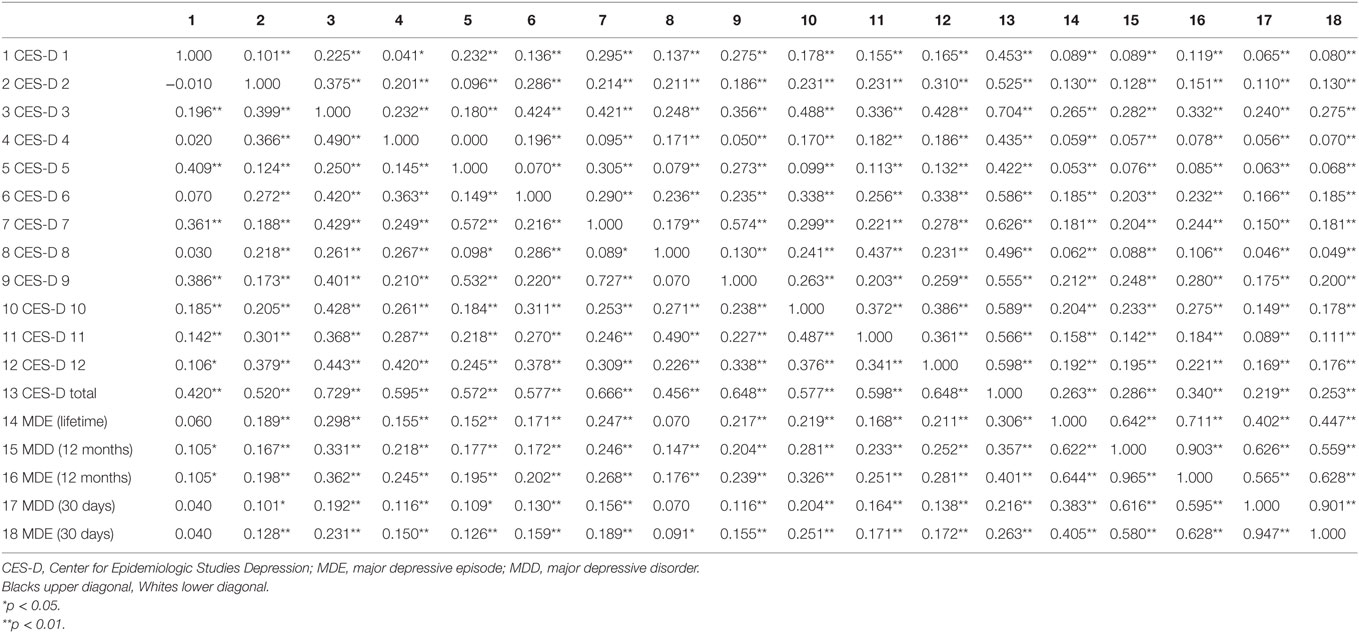
Table 2. Correlation matrix of CES-D scale items with CES-D total score, and DSM-based diagnoses among Blacks and Whites.
Factor Structure
Table 3 represents fit indices for the models. A comparison of chi-square values suggested that fits of the 3-factor models (i.e., Model 5 and Model 6, with correspondent Figure 5 and Figure 6) were significantly better than fits of the 2-factor models (i.e., Model 3 and Model 4, with correspondent Figure 3 and Figure 4). Similarly, fits of the 2-factor models (Figures 3 and 4) were significantly better than that of the 1-factor models (i.e., Model 1 and Model 2, with correspondent Figure 1 and Figure 2).
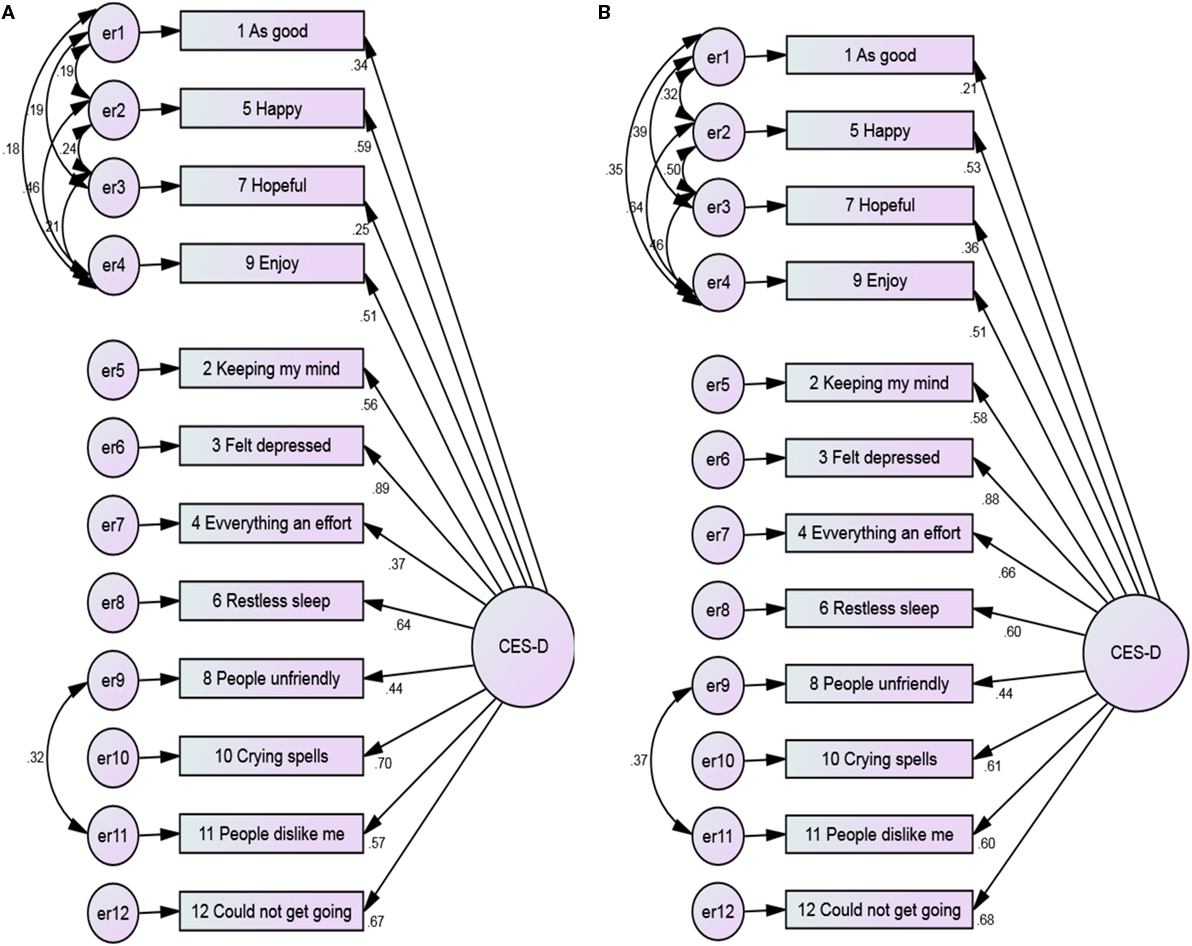
Figure 1. The 1-factor model of the CES-D 12, with error covariance and no constraints among Blacks and Whites. (A) Blacks and (B) Whites.
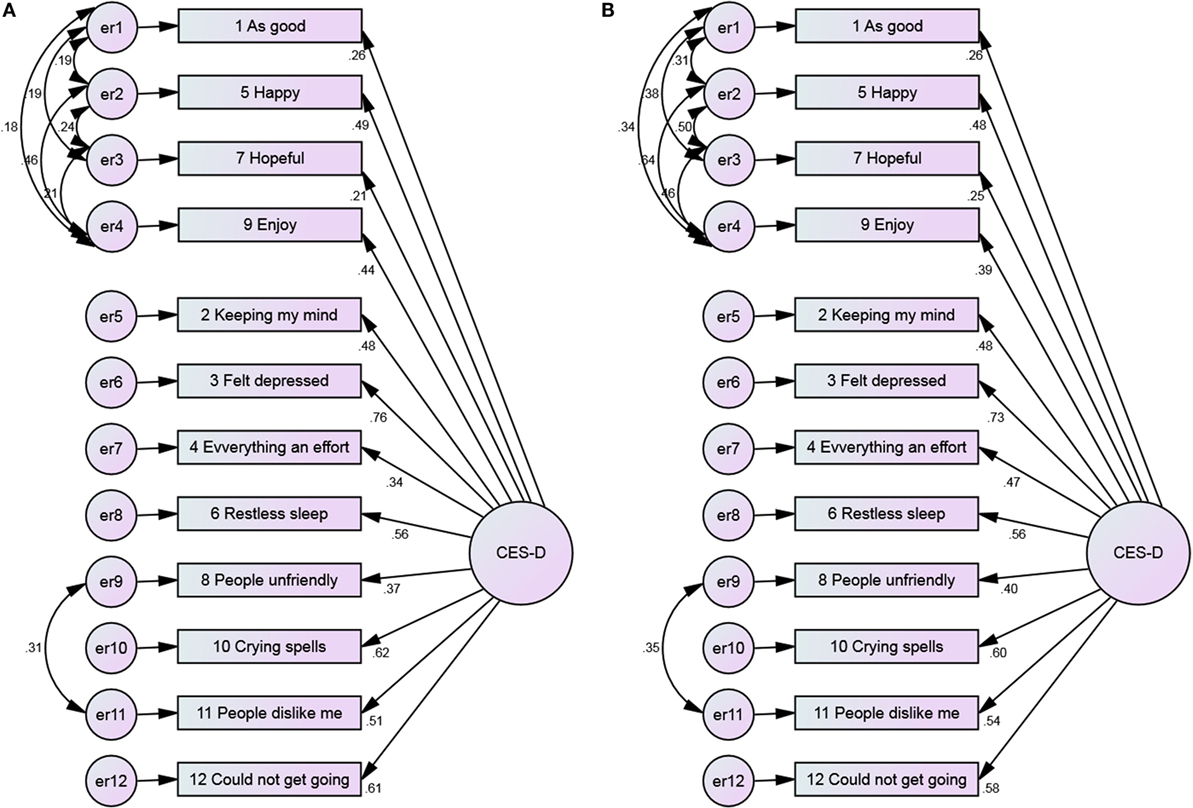
Figure 2. The 1-factor model of the CES-D 12, with error covariance and constraints among Blacks and Whites. (A) Blacks and (B) Whites.
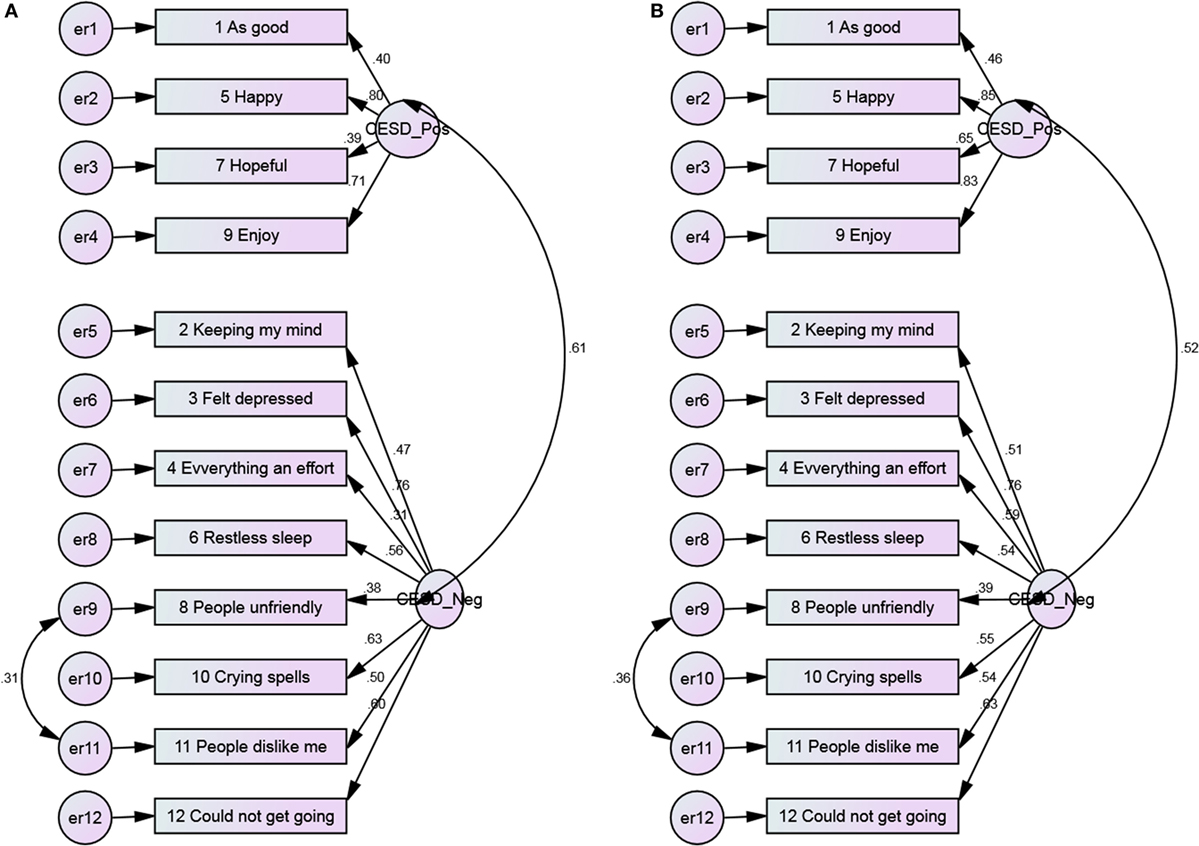
Figure 3. The 2-factor model of the CES-D 12, with error covariance and no constraints among Blacks and Whites. (A) Blacks and (B) Whites.
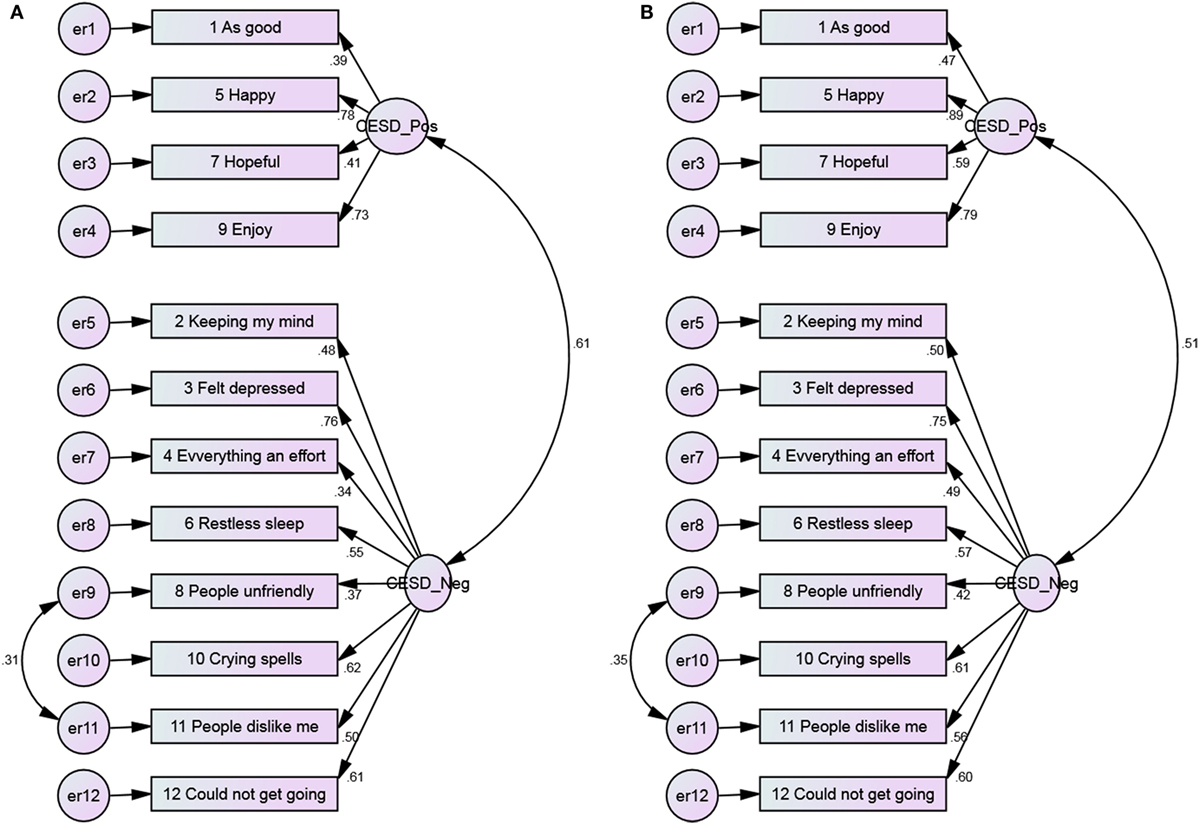
Figure 4. The 2-factor model of the CES-D 12, with error covariance and constraints among Blacks and Whites. (A) Blacks and (B) Whites.
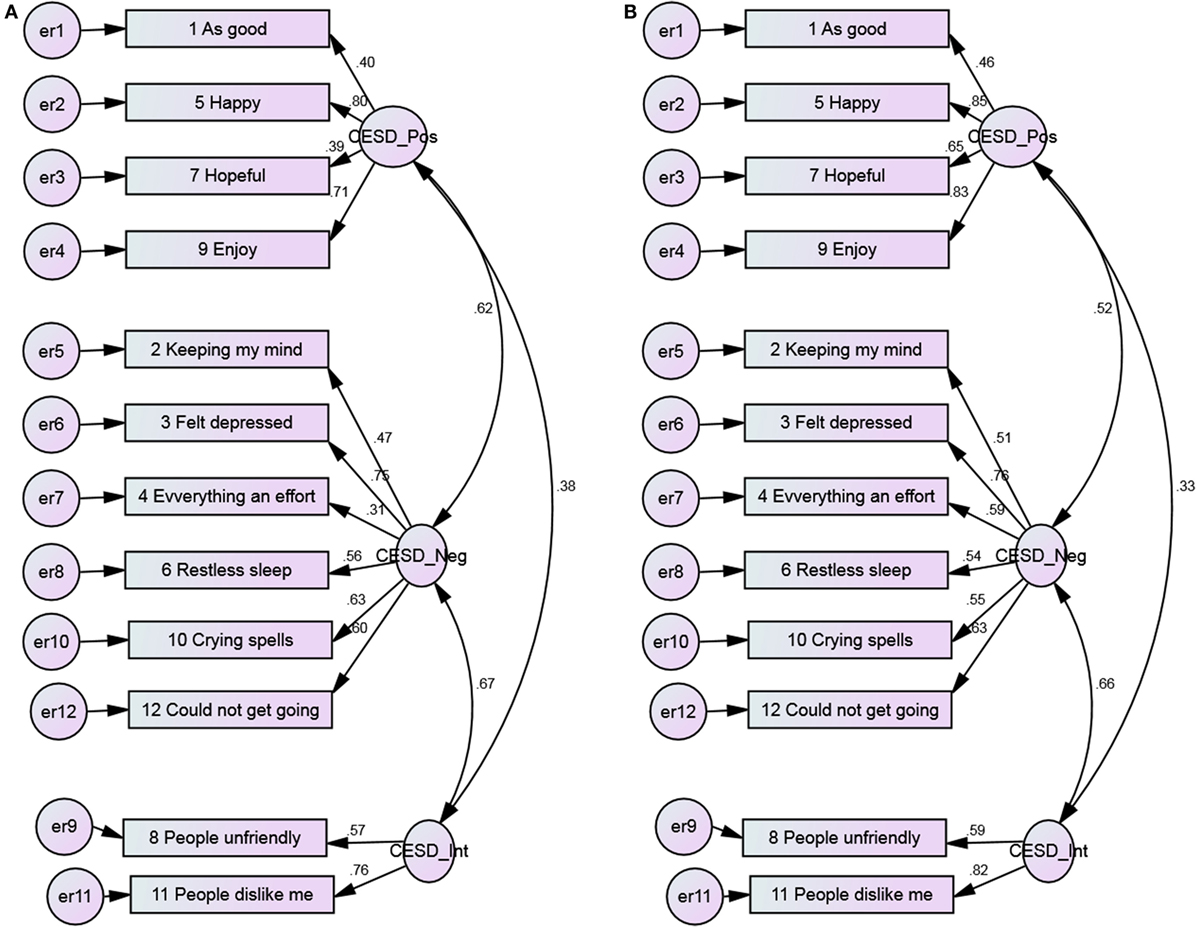
Figure 5. The 3-factor model of the CES-D 12, with error covariance and no constraints among Blacks and Whites. (A) Blacks and (B) Whites.
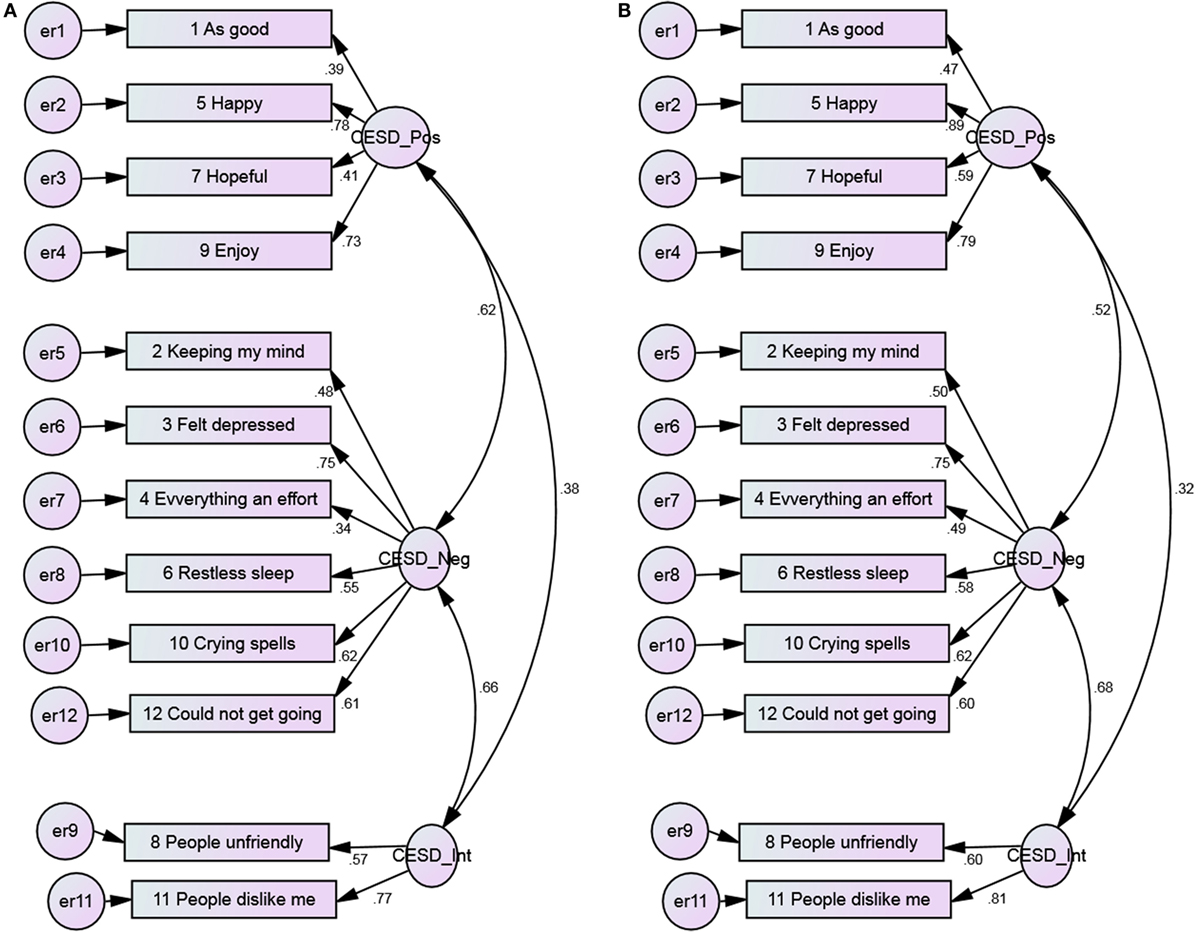
Figure 6. The 3-factor model of the CES-D 12, with error covariance and constraints among Blacks and Whites. (A) Blacks and (B) Whites.
As model fit significantly improved from the 1-factor model to the 3-factor model, the 3 factor model was considered as the optimum solution (chi-square = 596.60, CFI = 0.96, RMSEA = 0.03, p < 0.001) for both Blacks and Whites (Table 3). This also suggested invariance of the factor structure between Blacks and Whites.
Model fits significantly changed after imposing constraints to the models, suggesting lack of invariance of the loadings between Blacks and Whites. This pattern was seen for 1-, 2-, and 3-factor models (Table 3).
Item Loadings for Blacks and Whites
For both Blacks and Whites, the loadings were worst for the 1-factor model and the loading of the item “as good” was very poor. Among Blacks, item “hopeful” also had very poor loadings; however, this item had a better loading for Whites. The loadings considerably improved with adding number of factors from 1 to 3.
Positive items had weaker covariance among Blacks compared to Whites (Figures 1 and 2). As Figures 3 and 4 suggest, for 2-factor solution, loading for item “people unfriendly” among Whites and loadings for items “as good,” “hopeful,” “everything effort,” and “people unfriendly” among Blacks are poor. The covariance of positive and negative factors was slightly higher for Blacks, suggesting that positive and negative factors correlate slightly better in Blacks compared to Whites (Figures 3 and 4). Poor loadings for items “as good,” “keeping mind,” “everything effort,” and “hopeful” were seen in the final 3-factor model for Blacks, while the only item with poor loading in this model for Whites was item “as good” (Figures 5 and 6).
Range of Loadings for Each Dimension
In the 1-factor model of the 12-item CES-D scale with constraints and error covariance, item loadings varied between 0.21 and 0.76 for Blacks and 0.25 and 0.73 for Whites (Figure 2).
The 2-factor model of the 12-item CES-D scale with error covariance and constraints ranged from 0.39 to 0.78 (Blacks) and 0.47 to 0.89 (Whites) for positive affect, and 0.34 to 0.76 (Blacks) and 0.42 to 0.75 (Whites) for negative affect (Figure 4).
The 3-factor model of the 12-item CES-D scale, with error covariance and constraints ranged from 0.39 to 0.83 (Blacks) and 0.47 to 0.89 (Whites) for positive affect, 0.34 to 0.75 (Blacks) and 0.49 to 0.75 (Whites) for negative affect, 0.57 to 0.77 (Blacks) and 0.60 to 0.81 (Whites) for interpersonal items (Figure 6).
Discussion
Through the literature on factor analysis of the CES-D scale among racial and ethnic groups, often invariance of factor structure has been demonstrated while the invariance of loadings has been difficult to establish (24, 37). In other words, factor structure and overall fit of the models are major determinants of measurement equality among racial/ethnic groups and have been subject to invariance in several studies up to now, while the item loadings are subject to more variance due to measurement bias or characteristics of the study sample.
The current study showed invariance for factor structure; however, lack of invariance for item loadings of the 12-item CES-D scale between Blacks and Whites. Although we could not find systematic Black–White differences in the structure of the 12-item CES-D scale, several item loadings were worse among Blacks than Whites. Despite the acceptable fit of our final model, poor loadings were found for more items (i.e., “as good,” “hopeful,” “keeping mind,” and “everything effort”) among Blacks than Whites (i.e., “as good”).
The invariance of factor structure of the 12-item CES-D scale in this study is in line with CFA for the original 20-item CES-D scale in previous studies, which found the same factor model for Blacks (27), Black women (55, 56), and Black caregivers (57, 58). Torres used the NSAL data and showed that among Black men with Caribbean ancestral ties, CES-D scale scores were not associated with CIDI-based MDD or dysthymia (59). The author found that among Blacks and Black men with Caribbean ancestral ties, the item “I felt that I was just as good as other people” had item-to-total correlations and inter-item correlations below 0.30, and in all groups, the item “I felt like everything I did was an effort” also had item-to-total correlations and inter-item correlations below 0.30 (59); however, Torres did not use CFA and did not include Whites. Thus, our study is not the first to report psychometric limitations of the CES-D scale when applied to multiple racial groups. Previous studies warned that CES-D scale scores should be interpreted with caution in different populations, particularly when comparing scores across racial groups (59, 60).
The results of our CFA for the 12-item CES-D scale indicated invariance of factor structure between Blacks and Whites, with the 3-factor model being the best model among those analyzed. Our results are in line with the recently published paper on exploratory factor analysis of the 11-item CES-D scale (24). Meta-analysis of 4-factor model of the 20-item CES-D scale has previously called into question the appropriateness of such a model for application across multiple racial and ethnic groups (37). On the other hand, CFA of the 20-item CES-D scale among several hundred Black and White women proposed the 2-factor model as the best model (29); however, relatively small sample size and applying models only to the women are among the limitations of that study. Interestingly, in line with our 3-factor model, somatic complaints and depressive affect lack conceptual distinctions in 4-factor model of the 20-item CES-D scale (27). As an explanation, evidence shows that in some cultures, depression may be expressed through somaticized symptoms rather than depressive affect, and somatic complaints in individuals are more associated with experiences of depressive affect rather than positive affect or interpersonal problems (38–40, 44).
The differences in item loadings as well as fit with and without constraints between Blacks and Whites imply lack of invariance of the CES-D scale between Blacks and Whites in terms of items. In comparison to Whites, Blacks showed systematically lower item loadings except for interpersonal problem items. Previous research has documented disproportionately higher endorsement of interpersonal problem items among Blacks compared to Whites (23, 26, 61). These notions imply the need for further studies on measurement equivalence of the CES-D scale among racial and ethnic groups and a need for cross-validating measures of depression such as the CES-D scale with diagnosis of depression based on structured interviews and physician diagnosis.
We found differences for several items between Blacks and Whites, including item “happy.” Canady et al. found the item “happy” as the only item among the 20-items of original CES-D scale with different loadings between Blacks and Whites after applying the cross-group constraints (29). The sample of the study by Canady et al. was subject to strict matching. Future research should test whether any of these differences in item loadings is a function of socioeconomics or genuine cultural differences in experience and endorsement of depressive symptoms.
Appropriate latent factorial structure of the CES-D scale has implications for clinicians as well as researchers. Putting the items into definite clusters when assessing CES-D scale scores is of clinical importance considering that different ethnic groups may respond to treatments through changes in scores of different symptom clusters (38, 62). Furthermore, it is suggested that Blacks may report more somatic complaints than affect changes due to depression (39), which in turn necessitates both clinicians and researchers to take into account the cultural background of the individuals when interpreting the results of such measures. Future research should be directed toward the reliability of measuring depressive symptoms in different racial/ethnic groups, whether to improve currently available methods or to develop new tools.
This study is subject to several limitations. First, we did not consider potential gender differences in our CFA. Second, similar to most other studies on abbreviated CES-D scales, we did not estimate the fit for the 4-factor model. The reason we did not test the 4-factor model was that we only had 12 items. Third, the difference in sample size between Blacks and Whites may have a potential impact on the results of this study; however, the real extent of this impact is unclear. Among the strengths of this study, which distinguish it from most previous studies, are using a nationally representative sample and large sample size.
In conclusion, the present study indicated invariance of the factor structure for the 12-item CES-D scale in Blacks and Whites. Thus, at least in part, measurement bias associated with using the CES-D scale should be considered when comparing Blacks and Whites for correlates of depression. Further research is warranted to scrutinize the role of socioeconomic and cultural factors that may partially explain Black–White differences in measurement properties of the CES-D scale for depressive symptoms.
Author Contributions
SA was responsible for the design and analysis of the study. Both authors revised the manuscript and approved the final draft. EM-Z performed a comprehensive literature review and provided the first draft of the manuscript.
Conflict of Interest Statement
SA and EM-Z declare that they have no competing interests.
Acknowledgments
SA is supported by the Heinz C. Prechter Bipolar Research Fund and the Richard Tam Foundation at the University of Michigan Depression Center.
Funding
The National Survey of American Life (NSAL) is supported by the National Institute of Mental Health (NIMH; U01-MH57716) with supplemental support from the Office of Behavioral and Social Science Research (OBSSR) and the National Institute on Drug Abuse (NIDA) at the National Institutes of Health (NIH) and the University of Michigan. Data were downloaded from The Interuniversity Consortium for Political and Social Research (ICPSR), Institute for Social Research (ISR), University of Michigan.
References
1. Whiteford HA, Ferrari AJ, Degenhardt L, Feigin V, Vos T. The global burden of mental, neurological and substance use disorders: an analysis from the global burden of disease study 2010. PLoS One (2015) 10(2):e0116820. doi:10.1371/journal.pone.0116820
2. Dunlop DD, Song J, Lyons JS, Manheim LM, Chang RW. Racial/ethnic differences in rates of depression among preretirement adults. Am J Public Health (2003) 93(11):1945–52. doi:10.2105/AJPH.93.11.1945
3. Blazer DG, Landerman LR, Hays JC, Simonsick EM, Saunders WB. Symptoms of depression among community-dwelling elderly African-American and White older adults. Psychol Med (1998) 28(06):1311–20. doi:10.1017/S0033291798007648
4. González HM, Haan MN, Hinton L. Acculturation and the prevalence of depression in older Mexican Americans: baseline results of the Sacramento Area Latino Study on Aging. J Am Geriatr Soc (2001) 49(7):948–53. doi:10.1046/j.1532-5415.2001.49186.x
5. Foley KL, Reed PS, Mutran EJ, DeVellis RF. Measurement adequacy of the CES-D among a sample of older African-Americans. Psychiatry Res (2002) 109(1):61–9. doi:10.1016/S0165-1781(01)00360-2
6. Becker AE, Kleinman A. Mental health and the global agenda. N Engl J Med (2013) 369(1):66–73. doi:10.1056/NEJMra1110827
7. Robins LN, Wing J, Wittchen HU, Helzer JE, Babor TF, Burke J, et al. The Composite International Diagnostic Interview: an epidemiologic instrument suitable for use in conjunction with different diagnostic systems and in different cultures. Arch Gen Psychiatry (1988) 45(12):1069–77. doi:10.1001/archpsyc.1988.01800360017003
8. Wittchen HU. Reliability and validity studies of the WHO-Composite International Diagnostic Interview (CIDI): a critical review. J Psychiatr Res (1994) 28(1):57–84. doi:10.1016/0022-3956(94)90036-1
9. Kessler RC, Wittchen HU, Abelson JM, Mcgonagle K, Schwarz N, Kendler KS, et al. Methodological studies of the Composite International Diagnostic Interview (CIDI) in the US national comorbidity survey (NCS). Int J Methods Psychiatr Res (1998) 7(1):33–55. doi:10.1002/mpr.33
10. Kessler RC, Calabrese JR, Farley PA, Gruber MJ, Jewell MA, Katon W, et al. Composite International Diagnostic Interview screening scales for DSM-IV anxiety and mood disorders. Psychol Med (2013) 43(08):1625–37. doi:10.1017/S0033291712002334
11. Assari S, Lankarani MM, Moazen B. Religious beliefs may reduce the negative effect of psychiatric disorders on age of onset of suicidal ideation among Blacks in the United States. Int J Prev Med (2012) 3(5):358–64.
12. Assari S, Lankarani MM, Lankarani RM. Ethnicity modifies the effects of anxiety and drug use on suicidal ideation among Black adults in the United States. Int J Prev Med (2013) 4(11):1251–7.
13. Radloff LS. The CES-D scale a self-report depression scale for research in the general population. Appl Psychol Meas (1977) 1(3):385–401. doi:10.1177/014662167700100306
14. Gebara CF, Ferri CP, Lourenço LM, Vieira MT, Bhona FM, Noto AR. Patterns of domestic violence and alcohol consumption among women and the effectiveness of a brief intervention in a household setting: a protocol study. BMC Womens Health (2015) 15(1):78. doi:10.1186/s12905-015-0236-8
15. Boutin-Foster C. An item-level analysis of the Center for Epidemiologic Studies Depression Scale (CES-D) by race and ethnicity in patients with coronary artery disease. Int J Geriatr Psychiatry (2008) 23(10):1034–9. doi:10.1002/gps.2029
16. Coman EN, Iordache E, Schensul JJ, Coiculescu I. Comparisons of CES-D depression scoring methods in two older adults ethnic groups. The emergence of an ethnic-specific brief three-item CES-D scale. Int J Geriatr Psychiatry (2013) 28(4):424–32. doi:10.1002/gps.3842
17. Skriner LC, Chu BC. Cross-ethnic measurement invariance of the SCARED and CES-D in a youth sample. Psychol Assess (2014) 26(1):332. doi:10.1037/a0035092
18. Amtmann D, Kim J, Chung H, Bamer AM, Askew RL, Wu S, et al. Comparing CESD-10, PHQ-9, and PROMIS depression instruments in individuals with multiple sclerosis. Rehabil Psychol (2014) 59(2):220. doi:10.1037/a0035919
19. Zhang W, O’Brien N, Forrest JI, Salters KA, Patterson TL, Montaner JS, et al. Validating a shortened depression scale (10 item CES-D) among HIV-positive people in British Columbia, Canada. PLoS One (2012) 7(7):e40793. doi:10.1371/journal.pone.0040793
20. Roberts RE. Reliability of the CES-D scale in different ethnic contexts. Psychiatry Res (1980) 2(2):125–34. doi:10.1016/0165-1781(80)90069-4
21. Aneshensel CS, Clark VA, Frerichs RR. Race, ethnicity, and depression: a confirmatory analysis. J Pers Soc Psychol (1983) 44(2):385. doi:10.1037/0022-3514.44.2.385
22. Jackson JS, Torres M, Caldwell CH, Neighbors HW, Nesse RM, Taylor RJ, et al. The National Survey of American Life: a study of racial, ethnic and cultural influences on mental disorders and mental health. Int J Methods Psychiatr Res (2004) 13(4):196–207. doi:10.1002/mpr.177
23. Cole SR, Kawachi I, Maller SJ, Berkman LF. Test of item-response bias in the CES-D scale: experience from the New Haven EPESE study. J Clin Epidemiol (2000) 53(3):285–9. doi:10.1016/S0895-4356(99)00151-1
24. Moazen-Zadeh E, Assari S. Depressive symptoms predict major depressive disorder after 15 years among Whites but not Blacks. Front Public Health (2016) 4:13. doi:10.3389/fpubh.2016.00013
25. Assari S, Moazen-Zadeh E. Ethnic variation in the cross-sectional association between domains of depressive symptoms and clinical depression. Front Psychiatry (2016) 7:53. doi:10.3389/fpsyt.2016.00053
26. Kim G, Chiriboga DA, Jang Y. Cultural equivalence in depressive symptoms in older White, Black, and Mexican-American adults. J Am Geriatr Soc (2009) 57(5):790–6. doi:10.1111/j.1532-5415.2009.02188.x
27. Nguyen HT, Kitner-Triolo M, Evans MK, Zonderman AB. Factorial invariance of the CES-D in low socioeconomic status African Americans compared with a nationally representative sample. Psychiatry Res (2004) 126(2):177–87. doi:10.1016/j.psychres.2004.02.004
28. Callahan CM, Wolinsky FD. The effect of gender and race on the measurement properties of the CES-D in older adults. Med Care (1994) 32(4):341–56. doi:10.1097/00005650-199404000-00003
29. Canady RB, Stommel M, Holzman C. Measurement properties of the Centers for Epidemiological Studies Depression Scale (CES-D) in a sample of African-American and non-Hispanic White pregnant women. J Nurs Meas (2009) 17(2):91. doi:10.1891/1061-3749.17.2.91
30. Watson D, Clark LA. Measurement and mismeasurement of mood: recurrent and emergent issues. J Pers Assess (1997) 68(2):267–96. doi:10.1207/s15327752jpa6802_4
31. Wichers M, Jacobs N, Derom C, Thiery E, van Os J. Depression: too much negative affect or too little positive affect? Twin Res Human Genet (2007) 10(S1):19–20. doi:10.1375/twin.10.supp.19
32. Assari S, Lankarani MM. Whites’ depression more hopeless than Blacks’ depression; a national study of older adults. Front Public Health (2016) 4:82. doi:10.3389/fpubh.2016.00082
33. Merz EL, Malcarne VL, Roesch SC, Ko CM, Emerson M, Roma VG, et al. Psychometric properties of Positive and Negative Affect Schedule (PANAS) original and short forms in an African American community sample. J Affect Disord (2013) 151(3):942–9. doi:10.1016/j.jad.2013.08.011
34. Jang Y, Kwag KH, Chiriboga DA. Not saying I am happy does not mean I am not: cultural influences on responses to positive affect items in the CES-D. J Gerontol B Psychol Sci Soc Sci (2010) 65(6):684–90. doi:10.1093/geronb/gbq052
35. Black HK, White T, Hannum SM. The lived experience of depression in elderly African American women. J Gerontol B Psychol Sci Soc Sci (2007) 62(6):S392–8. doi:10.1093/geronb/62.6.S392
36. Hales DP, Dishman RK, Motl RW, Addy CL, Pfeiffer KA, Pate RR. Factorial validity and invariance of the Center for Epidemiologic Studies Depression (CES-D) scale in a sample of Black and White adolescent girls. Ethn Dis (2005) 16(1):1–8.
37. Kim G, DeCoster J, Huang CH, Chiriboga DA. Race/ethnicity and the factor structure of the Center for Epidemiologic Studies Depression Scale: a meta-analysis. Cultur Divers Ethnic Minor Psychol (2011) 17(4):381. doi:10.1037/a0025434
38. Angel R, Thoits P. The impact of culture on the cognitive structure of illness. Cult Med Psychiatry (1987) 11(4):465–94. doi:10.1007/BF00048494
39. Baker FM, Okwumabua J, Philipose V, Wong S. Screening African-American elderly for the presence of depressive symptoms: a preliminary investigation. J Geriatr Psychiatry Neurol (1996) 9(3):127–32. doi:10.1177/089198879600900304
40. Dick RW, Beals J, Keane EM, Manson SM. Factorial structure of the CES-D among American Indian adolescents. J Adolesc (1994) 17(1):73–9. doi:10.1006/jado.1994.1007
41. Assari S, Sonnega A, Pepin R, Leggett A. Residual effects of restless sleep over depressive symptoms on chronic medical conditions: race by gender differences. J Racial Ethn Health Disparities (2016). doi:10.1007/s40615-015-0202-z
42. Assari S, Moazen-Zadeh E, Lankarani MM, Foster VM. Race, depressive symptoms and all-cause mortality in the United States. Front Public Health (2016) 4:40. doi:10.3389/fpubh.2016.00040
43. Assari S, Burgard S. Black-White differences in the effect of baseline depressive symptoms on deaths due to renal diseases: 25 year follow up of a nationally representative community sample. J Renal Inj Prev (2015) 4(4):127. doi:10.12861/jrip.2015.27
44. Assari S, Burgard S, Zivin K. Long-term reciprocal associations between depressive symptoms and number of chronic medical conditions: longitudinal support for Black-White health paradox. J Racial Ethn Health Disparities (2015) 2(4):589–97. doi:10.1007/s40615-015-0116-9
45. Jackson JS, Neighbors HW, Nesse RM, Trierweiler SJ, Torres M. Methodological innovations in the national survey of American life. Int J Methods Psychiatr Res (2004) 13(4):289–98. doi:10.1002/mpr.182
46. Neighbors HW, Njai R, Jackson JS. Race, ethnicity, John Henryism, and depressive symptoms: the national survey of American life adult reinterview. Res Hum Dev (2007) 4(1–2):71–87. doi:10.1080/15427600701481004
47. Heeringa SG, Wagner J, Torres M, Duan N, Adams T, Berglund P. Sample designs and sampling methods for the Collaborative Psychiatric Epidemiology Studies (CPES). Int J Methods Psychiatr Res (2004) 13(4):221–40. doi:10.1002/mpr.179
48. Alegria M, Jackson JS, Kessler RC, Takeuchi D. Collaborative Psychiatric Epidemiology Surveys (CPES), 2001–2003 [United States]. ICPSR20240-v6. Ann Arbor, MI: Inter-University Consortium for Political and Social Research [Distributor] (2008). p. 06–19.
49. Andresen EM, Malmgren JA, Carter WB, Patrick DL. Screening for depression in well older adults: evaluation of a short form of the CES-D. Am J Prev Med (1994) 10(2):77–84.
50. Kline RB. Principles and Practice of Structural Equation Modeling. 3rd ed. New York: Guilford Press (2010).
51. Allison PD. Missing Data. Sage University Papers Series on Quantitative Applications in the Social Sciences, 07–136. Thousand Oaks: SAGE (2002).
53. Hu L, Bentler PM. Cutoff criteria for fit indexes in covariance structure analysis: conventional criteria versus new alternatives. Struct Equ Model (1999) 6:1–55. doi:10.1080/10705519909540118
54. Hooper D, Coughlan J, Mullen MR. Structural equation modelling: guidelines for determining model fit. Electron J Bus R Methods (2008) 6(1):53–60.
55. Makambi K, Williams C, Taylor T, Rosenberg L, Adams Campbell L. An assessment of the CES-D scale factor structure in Black women: the Black Women’s Health Study. Psychiatry Res (2009) 168(2):163–70. doi:10.1016/j.psychres.2008.04.022
56. Williams C, Taylor T, Makambi K, Harrell J, Palmer J, Rosenberg L, et al. CES-D four-factor structure is confirmed, but not invariant, in a large cohort of African American women. Psychiatry Res (2007) 150(2):173–80. doi:10.1016/j.psychres.2006.02.007
57. Roth D, Ackerman M, Okonkwo O, Burgio L. The four-factor model of depressive symptoms in dementia caregivers: a structural equation model of ethnic differences. Psychol Aging (2008) 23(3):567–76. doi:10.1037/a0013287
58. Flynn Longmire C, Knight B. Confirmatory factor analysis of the Center for Epidemiologic Studies-Depression Scale in Black and White dementia caregivers. Aging Ment Health (2010) 14(8):962–70. doi:10.1080/13607863.2010.501060
59. Torres E. Psychometric properties of the Center for Epidemiologic Studies Depression scale in African-American and Black Caribbean adults. Issues Ment Health Nurs (2012) 33(10):687–96. doi:10.3109/01612840.2012.697534
60. Gay CL, Kottorp A, Lerdal A, Lee KA. Psychometric limitations of the Center for Epidemiologic Studies-Depression Scale for assessing depressive symptoms among adults with HIV/AIDS: a Rasch analysis. Depress Res Treat (2016) 2016:2824595. doi:10.1155/2016/2824595
61. Yang FM, Jones RN. Center for Epidemiologic Studies-Depression scale (CES-D) item response bias found with Mantel-Haenszel method was successfully replicated using latent variable modeling. J Clin Epidemiol (2007) 60(11):1195–200. doi:10.1016/j.jclinepi.2007.02.008
Appendix
Keywords: racial groups, Blacks, African-Americans, Whites, depressive symptoms, Center for Epidemiologic Studies Depression, reliability
Citation: Assari S and Moazen-Zadeh E (2016) Confirmatory Factor Analysis of the 12-Item Center for Epidemiologic Studies Depression Scale among Blacks and Whites. Front. Psychiatry 7:178. doi: 10.3389/fpsyt.2016.00178
Received: 09 March 2016; Accepted: 13 October 2016;
Published: 07 November 2016
Edited by:
Michael Noll-Hussong, University of Ulm, GermanyReviewed by:
Crystal C. Watkins, Johns Hopkins School of Medicine, USAArcady A. Putilov, Institute of Molecular Biology and Biophysics (RAS), Russia
Marco Innamorati, Università Europea di Roma, Italy
Copyright: © 2016 Assari and Moazen-Zadeh. This is an open-access article distributed under the terms of the Creative Commons Attribution License (CC BY). The use, distribution or reproduction in other forums is permitted, provided the original author(s) or licensor are credited and that the original publication in this journal is cited, in accordance with accepted academic practice. No use, distribution or reproduction is permitted which does not comply with these terms.
*Correspondence: Shervin Assari, assari@umich.edu
 Shervin Assari
Shervin Assari Ehsan Moazen-Zadeh
Ehsan Moazen-Zadeh